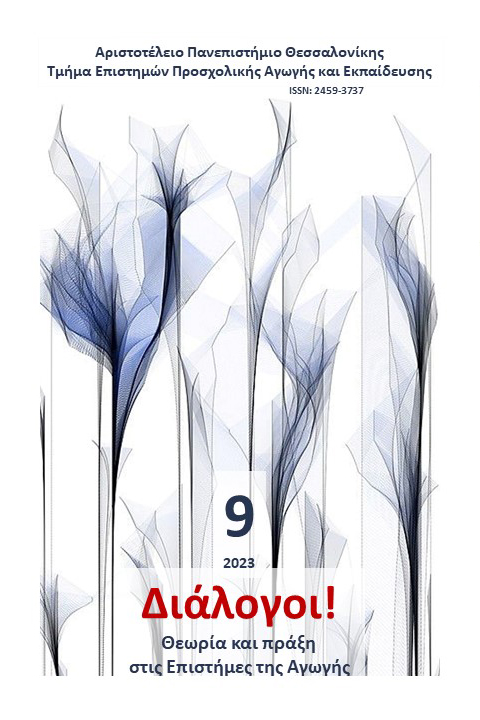Σχεδίαση και ανάπτυξη εφαρμογής επαυξημένης πραγματικότητας για φορητές συσκευές για τον εμπλουτισμό του λεξιλογίου σε παιδιά στο φάσμα του αυτισμού

Περίληψη
Το παρόν άρθρο μελετά την αξιοποίηση της τεχνολογίας της Επαυξημένης Πραγματικότητας (ΕΠ) στα πλαίσια ενίσχυσης των δεξιοτήτων των παιδιών προσχολικής αγωγής με Διαταραχές Αυτιστικού Φάσματος. Ειδικότερα, το άρθρο στοχεύει στην σχεδίαση και ανάπτυξη εφαρμογής ΕΠ για τον εμπλουτισμό του λεξιλογίου των παιδιών με ΔΑΦ, η οποία δύναται να χρησιμοποιηθεί στην εκπαιδευτική διαδικασία. Η εφαρμογή ΕΠ «Καρτόλεξο» καλύπτει το βιβλιογραφικό κενό που εντοπίζεται στις εφαρμογές Επαυξημένης Πραγματικότητας που απευθύνονται σε άτομα με ΔΑΦ για την ανάπτυξη των κοινωνικών τους δεξιοτήτων. Στην έρευνα συμμετείχαν 8 παιδιά προσχολικής αγωγής που βρίσκονται στο φάσμα του αυτισμού και η εφαρμογή αξιολογήθηκε από 3 εκπαιδευτικούς Πρωτοβάθμιας Εκπαίδευσης με εξειδίκευση στην Ειδική Αγωγή. Για να διερευνηθεί η αποτελεσματικότητα και η ευχρηστία της εφαρμογής ΕΠ «Καρτόλεξο» αξιοποιήθηκε η μεικτή μεθοδολογία με την συλλογή, ανάλυση και ερμηνεία ποιοτικών και ποσοτικών δεδομένων. Πιο συγκεκριμένα, οι εκπαιδευτικοί κλήθηκαν να απαντήσουν στην ημιδομημένη συνέντευξη και στο γραπτό ερωτηματολόγιο ευχρηστίας. Η εφαρμογή ΕΠ «Καρτόλεξο» σχεδιάστηκε παιδαγωγικά σύμφωνα με τις αρχές του εποικοδομισμού και η λειτουργικότητα της εφαρμογής βασίστηκε στους κανόνες ευχρηστίας του Nielsen (1993). Από την ανάλυση των δεδομένων προέκυψε ότι η εφαρμογή «Καρτόλεξο» μπορεί να βοηθήσει τα παιδιά με ΔΑΦ να αναπτύξουν το λεξιλόγιό τους με διασκεδαστικό τρόπο. Συμπερασματικά, η εφαρμογή ΕΠ «Καρτόλεξο» χαρακτηρίστηκε κατάλληλη, λειτουργική, εύχρηστη και με πλούσιο περιεχόμενο.
Λεπτομέρειες άρθρου
- Πώς να δημιουργήσετε Αναφορές
-
Κουκουνάρα Μ., & Χατζηνικολάου Κ. (2023). Σχεδίαση και ανάπτυξη εφαρμογής επαυξημένης πραγματικότητας για φορητές συσκευές για τον εμπλουτισμό του λεξιλογίου σε παιδιά στο φάσμα του αυτισμού. Διάλογοι! Θεωρία και πράξη στις επιστήμες αγωγής και εκπαίδευσης, 9, 199–226. https://doi.org/10.12681/dial.33934
- Τεύχος
- Τόμ. 9 (2023)
- Ενότητα
- Νέοι ερευνητές

Αυτή η εργασία είναι αδειοδοτημένη υπό το CC Αναφορά Δημιουργού – Μη Εμπορική Χρήση – Παρόμοια Διανομή 4.0.
Οι συγγραφείς των άρθρων που δημοσιεύονται στο Διάλογοι! Θεωρία και Πράξη στις Επιστήμες Αγωγής και Εκπαίδευσης διατηρούν τα δικαιώματα πνευματικής ιδιοκτησίας επί των άρθρων τους, δίνοντας στο περιοδικό το δικαίωμα της πρώτης δημοσίευσης. Άρθρα που δημοσιεύονται στο Διάλογοι! Θεωρία και Πράξη στις Επιστήμες της Αγωγής και Εκπαίδευσης διατίθενται με άδεια Creative Commons 4.0 και σύμφωνα με την άδεια μπορούν να χρησιμοποιούνται ελεύθερα, με αναφορά στον/στη συγγραφέα και στην πρώτη δημοσίευση για μη κερδοσκοπικούς σκοπούς και με δικαίωμα τροποποίησης μόνον με παρόμοια διανομή (αν αναμείξετε, τροποποιήσετε, ή δημιουργήσετε πάνω στο υλικό, πρέπει να διανείμετε τις δικές σας συνεισφορές υπό την ίδια άδεια όπως και το πρωτότυπο).
To Τμήμα Επιστημών Προσχολικής Αγωγής και Εκπαίδευσης του Αριστοτέλειου Πανεπιστημίου Θεσσαλονίκης και το Εθνικό Κέντρο Τεκμηρίωσης διατηρούν το δικαίωμα να δημοσιεύουν, να αναπαραγάγουν, να παρουσιάζουν στο κοινό, να διανέμουν και να χρησιμοποιούν άρθρα που δημοσιεύονται στο Διάλογοι! Θεωρία και Πράξη στις Επιστήμες Αγωγής και Εκπαίδευσης σε οποιοδήποτε μέσο και μορφή είτε μεμονωμένα είτε ως μέρη συλλογικών έργων, για όλο το χρόνο διάρκειας προστασίας της πνευματικής ιδιοκτησίας και για όλες τις χώρες του κόσμου.
Αυτό περιλαμβάνει ενδεικτικά, και όχι αποκλειστικά, το δικαίωμα δημοσίευσης των άρθρων σε τεύχη του περιοδικού Διάλογοι! Θεωρία και Πράξη στις Επιστήμες Αγωγής και Εκπαίδευσης, αναπαραγωγής και διανομής μεμονωμένων αντιγράφων των άρθρων, αναπαραγωγής ολόκληρων των άρθρων σε άλλη έκδοση του Τμήματος Επιστημών Προσχολικής Αγωγής και Εκπαίδευσης του Αριστοτέλειου Πανεπιστημίου Θεσσαλονίκης και του Εθνικού Κέντρου Τεκμηρίωσης και αναπαραγωγής και διανομής των άρθρων ή περίληψης αυτών με χρήση πληροφορικού συστήματος αποθετηρίου.


